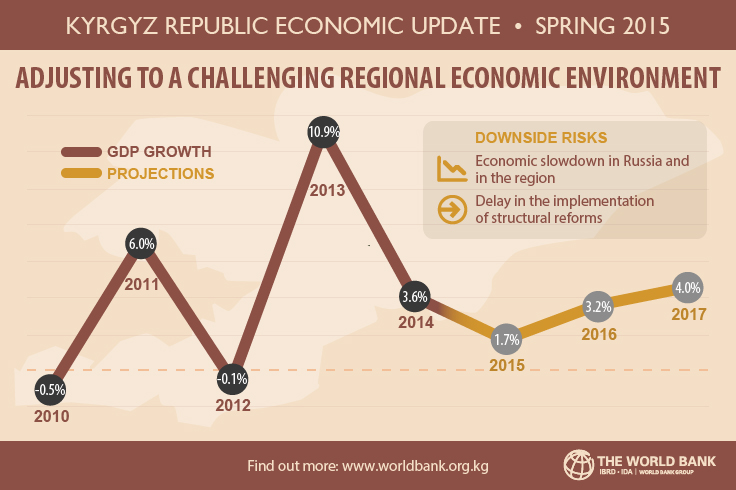Recent Economic Developments
Growth in the Kyrgyz Republic slowed significantly in 2014, reflecting the deteriorating external environment and supply-side constraints; real GDP growth fell to 3.6 percent, from 10.9 percent in the previous year.
Re-export businesses were affected as the Eurasian Economic Union (EEU) began to exercise stricter border control on goods imported from third countries. Lower production at the Kumtor gold mine and a poor harvest due to adverse weather also depressed growth.
Job creation was stagnant. Poverty remains high: the most recent (2013) national estimates are absolute poverty at 37 percent and extreme poverty at 2.8 percent.
While export growth was negative (–6.4 percent), imports declined even more (–7.2 percent) which, together with lower income outflows, led to a lower current account deficit at 13.7 percent of GDP, down from 15 percent in 2013.
On the fiscal side, slower growth affected tax revenues, which essentially remained flat at 25.3 percent of GDP in 2014 as a year earlier, but non-tax revenues went up by over a percentage point of GDP, to 6.7; together with grants, that brought total revenues to just under 35 percent of GDP.
At the same time, while current spending slightly declined as a share of GDP, a significant expansion of public investment spending brought the fiscal deficit to an estimated 4.1 percent of GDP in 2014, up from 3.9 percent in 2013.
Higher spending and the depreciation of the som translated into a significant increase in public debt, from 46.1 percent of GDP in 2013 to 53 percent for 2014.
The fall of the Russian ruble and the Kazakh tenge led to a significant depreciation of the Kyrgyz som against the US dollar which, together with increases in energy tariffs, drove inflation up from 4 percent in 2013 to 10.5 percent in December 2014.To curb inflation and credit growth, the National Bank of the Kyrgyz Republic tightened its monetary stance by increasing the interest rate from 6 percent in late June 2014 to 11 percent in December 2014.
Economic Outlook
Economic growth is projected to be anemic in 2015, but to recover slowly thereafter. With remittances expected to decline further and external demand to remain weak, real GDP growth is projected to decline to 1.7 percent in 2015.
Assuming that external demand for Kyrgyz goods and labor recovers, growth is expected to pick up to 4 percent in 2017.
While the deficit is likely to expand to 7.6 percent of GDP in 2015 because of higher public investment, a reduction in non-investment spending should help bring the deficit back to about 4 percent of GDP by 2017.
However, the risks to this outlook are significant. A protracted slowdown in Russia and in the region will reduce remittances and put further pressures on the exchange rate and prices.
Domestically, political institutions that are still evolving may limit the ability of the government to implement reforms. The parliamentary elections in October 2015 might also delay some reforms. Taken together, these factors may cloud the growth outlook and jeopardize poverty reduction gains.
